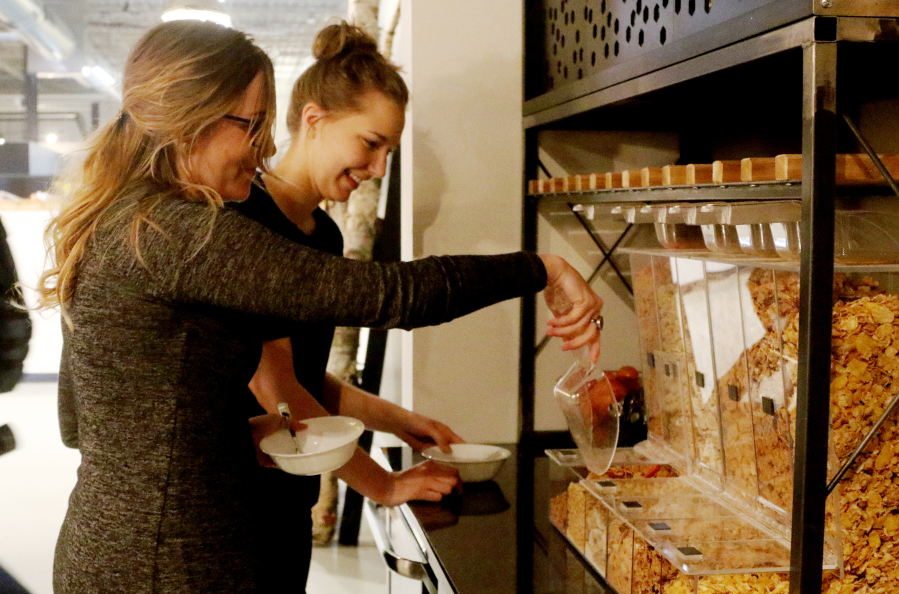MINNEAPOLIS — Ashley Peters is the kind of consumer cereal-makers like General Mills both court and fear.
She grew up eating breakfast cereal — from Cheerios to Cap’n Crunch — and now, at age 30, she’s part of the coveted millennial demographic. But these days, Peters usually reaches for a granola bar at breakfast, which she often eats on the job.
“It’s just easier to do,” said Peters, a communications manager at a St. Paul nonprofit group. “I don’t have time for milk at work.”
Cereal is still king of the American breakfast, but its realm is shrinking as consumers look for more convenience and variety.
The percent of in-home breakfast meals that include cereal dropped from 31 percent in 2009 to 26.8 percent last year, according to market researcher NPD Group.
Meanwhile, U.S. cold cereal sales have fallen 9 percent from 2011 through 2015, according to market researcher Nielsen. Over those four years, breakfast cereal experienced a bigger sales contraction in absolute numbers than any other packaged food business, including the ailing soft-drink industry, Nielsen data show.
This is all particularly bad news for Minnesota, home of General Mills, one of the nation’s two mega-cereal-makers along with archrival Kellogg. The state also is a big hub for the No. 3 U.S. cereal company, Post Holdings, which last year bought the former Malt-O-Meal company and its plant in the state. Post now runs its cereal business out of suburban Minneapolis.
Cereal manufacturers haven’t been bowling over customers with innovative products in recent years. But they are finding other ways to fight back, excising dyes and other ingredients perceived as unhealthy. They’re marketing cereal as an alternative to other snacks.
“I’ve heard cereal being killed off three or four times in my career,” said Jim Murphy, head of General Mills’ U.S. cereal division. “But it’s a highly resilient category.”
Cereal is General Mills’ biggest U.S. retail business, generating $2.3 billion in annual sales or 13 percent of total revenue. The company, which turns 150 this year, began making cereal in the 1920s with the launch of Wheaties. These days, General Mills’ Honey Nut Cheerios is America’s top-selling cereal, and Big G and Kellogg each control about 30 percent of the U.S. cereal business.
Ready-to-eat breakfast cereal was originally sold on its convenience, and it’s still hardly a tall order to fix up a bowl of Cheerios. But cereal isn’t very portable, and food portability is increasingly important to consumers.
“I know cereal doesn’t take much time, but it’s one more thing to do,” said Peters, who eats breakfast on the go.
A study last summer by consumer research group Mintel concluded that convenience at breakfast was especially critical among millennials, defined by Mintel as between ages 22 and 39. Measured against three older groups, millennials by far agreed most with the idea that cereal should be more portable, and that cereal is inconvenient because it involves washing dishes.
Other researchers aren’t sold on the notion that millennials have soured on cereal just because of inconvenience.
“When we look at the food consumption trends of millennials, they are increasingly involved in food preparation,” said Darren Seifer, food industry analyst at NPD Group. “They will spend more time with their food.”
General Mills’ main offensive pivots on removing unwanted ingredients from its prime brands.
Last year, the company began selling gluten-free versions of Honey Nut Cheerios and classic Cheerios. Gluten, a protein in wheat, is harmful to those with celiac disease or other wheat allergies. While less than 10 percent of the population has such conditions, many consumers are trying to avoid gluten for perceived health reasons.
General Mills says the gluten-free effort is working: Sales of Cheerios, including Honey Nut, were up 2 percent for the nine months ending in February, after being down 8 percent in the previous year.
Mills executives are also optimistic about another project: extracting artificial colors and flavors. Naturally colored and flavored versions of Trix, Reese’s Puffs and other cereals hit the market in January and registered strong sales gains.
“This is exactly what the millennial mom wants,” said Mills’ Murphy. He sees General Mills’ cereal sales soon turning positive after more than three years of stagnation.
“I think we are going to grow this quarter,” Murphy said. Cereal, he said, is heading back to a growth rate of 1 to 3 percent.
Murphy points out that cereal still has a bigger presence in consumers’ cupboards than any other breakfast item. Half of Americans eat cereal for breakfast at least once a week, according to NPD. Eggs and coffee are next, each tallying 36 percent.



